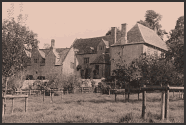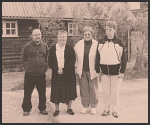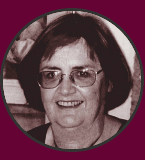VISIT TO SNOWSHILL MANOR
26th April 2003
 The Snowshill 'atmosphere' begins to creep up on you as soon as you turn by the village green and leave the main tourist street of Broadway. The narrow lane with its passing places climbs upwards past picturesque houses made of mellow Cotswold stone until, over the high hedges, you glimpse a magnificent vista of hills and valleys, which on that late April Saturday displayed only a hint of wakening blossom. The Manor itself is hidden in a secret valley and the house cannot be seen from the road, although if you drive on into the village of Snowshill itself, you skirt its back wall. The Snowshill 'atmosphere' begins to creep up on you as soon as you turn by the village green and leave the main tourist street of Broadway. The narrow lane with its passing places climbs upwards past picturesque houses made of mellow Cotswold stone until, over the high hedges, you glimpse a magnificent vista of hills and valleys, which on that late April Saturday displayed only a hint of wakening blossom. The Manor itself is hidden in a secret valley and the house cannot be seen from the road, although if you drive on into the village of Snowshill itself, you skirt its back wall.
 I had arranged to meet the other members of the Supernatural SIG at 11.45 in the Manor's car park and was looking forward to meeting Kevin and his wife. We were joined by another Mensan, Joyce Stephenson and had a fascinating chat about 'things supernatural' which set the scene and about the Manor itself. But the proof of the pudding was in the eating... I had arranged to meet the other members of the Supernatural SIG at 11.45 in the Manor's car park and was looking forward to meeting Kevin and his wife. We were joined by another Mensan, Joyce Stephenson and had a fascinating chat about 'things supernatural' which set the scene and about the Manor itself. But the proof of the pudding was in the eating...
An hour later after lunch in the restaurant, we were handing over our timed tickets to a volunteer guide and standing in the hall of the Manor. It was gloomy and cold, mainly because the doors were wide open and the Spring day was cuttingly breezy as well as overcast. However, according to Kevin, several people who have come to Snowshill have commented at the threshold that the house has a "feeling" about it and one or two have even refused to enter...
The first impression you get is of the clutter that derives from a life time of frenzied collecting. Charles Wade was interested in everything from the smallest curio to the large carriage and he even collected a fire-engine. It was his life's work and he filled every inch of the Manor with priceless treasures as well as what many people would label as 'tat'.
For me, the tiny objects were the most fascinating - to think of the time that it must have taken to carve an ivory bodkin intricately or create the smallest furniture in the dolls' house. There are many exquisite artefacts and curious paraphernalia but everything is imbued with the thick atmosphere of age and the past. If ever one might find a ghost, it could be here. But we didn't see one!
Amongst so much, it is difficult to pick out one's favourites. But here are mine: In a ground floor room as wonderfully detailed artefact made by a genius, who had no arms.
On the first floor a stunning collection of full-size macabre Samurai warriors meet in the gloom of the Green Room. They were acquired by Charles Wade after the Second World War. They are fearsome, so much so, that Joyce, who had seen them before, didn't want to look at them again. Set in warlike stance against a temple background, their armour and weapons are breathtaking. Once more, the initial effect is dark and threatening but, a moment later is dispelled by a board containing a detailed explanation by the National Trust about the experiment they are carrying out on keeping the dust away!
The top floor was certainly very interesting. We learned the most amazing fact up there. The Manor is to be closed in November 2003 and cleaned from top to bottom. Every object is to be taken out and stored. It is hard to imagine how it can be done and who will carry out the work of moving and, even more amazing, replacing the artefacts...
When Charles Wade began restoring the rooms on the first floor, he sent a piece of roof timber to a clairvoyant in Brighton. She wrote in her psychometric reading: 'Two houses upon a steep slope - the larger, lofty and mysterious. In the lofty house in an upper room. Late at night there is a girl in a green dress of the seventeenth century - she is greatly agitated - she paces anxiously up and down the room - she doesn't live here and will not stay the night.'
Charles Wade later discovered that a secret marriage took place in an upper room on St Valentines Eve, 1604. Anne Parsons, a sixteen year old heiress had been forcibly married there to a fortune-seeker at the dead of night. But she refused to stay in the house for the night.
As we climbed up to the attics, Kevin told us there is also a room with a pentagram on the floor and other mystic symbols on the walls. He had tried to gain access for us but it was denied. When the National Trust took possession of the house, they found an assortment of objects that may have belonged to an alchemist or wizard of the Middle Ages. These are now in a Museum of Witchcraft in Boscastle in Cornwall.
However all we saw in the attics was a marvellous display of carts and carriages, ranging from large farm carts to Victorian bath chairs, bicycles of all ages, including several penny farthings and prams for children and dolls. In another room stands a replica of an enormous mediaeval clock designed by Mr Wade himself, which is set to chime at certain times of the day and also an authentic weaving loom from a village near Snowshill. Charles Wade ceaselessly travelled the British Isles as well as abroad to add to his collection. Anything and everything caught his eye.
A bizarre thought struck as I was walking round - that reality television would have a field day if ever invited to tidy up Snowshill! Nothing I had ever seen could compare with the 'junk' as some would call it, but that junk is priceless, because of its age and very diversity!
Coming downstairs, we entered a chamber where two fine swords hung over the mantelpiece. It is rumoured that these were murder weapons and could be another cause of unrest as the blades were involved in a duel where one of the participants was killed.
Throughout our expedition, I marvelled at how Charles Wade had collected such a motley conglomeration of everything. In fact, he lived and slept, not in the Manor, but in an outbuilding which you can visit as you leave the main house. It is a wonder in itself that such a wealthy man should have chosen such poverty. The rooms remain, Miss Havisham-like, just as they were when he died and reminiscent for me of the farming peasant houses of Eastern Europe.
There is no firm evidence that Charles Wade dabbled in the Black Arts, However Peter Underwood in The Vampire's Bedside Companion hints that he may have been a vampire. There is little evidence to support this other than his sleeping with a large preserved bat above his bed, - hardly to everyone's taste! - and his eccentric nature and sinister appearance which he liked to emphasise. Two of our indomitable little party climbed the stone stairs to look for the bat while Joyce and I languished outside after an exhausting morning's ghost-hunting.
On my way back down the lane, I thought of the rest of the information Kevin had offered...
In the nineteenth century Charles Marshall lived at Snowshill. After his death Richard Carter a labourer working at Hill Barn was returning home when he encountered his former master Charles Marshall riding beside him on a black pony. This happened several times.
The frightened labourer told the rector, who advised him to confront the ghost with the words, "What troublest thou here in the Name of the Lord." The ghost told Carter to meet him at midnight in the chaff-house. This he did and was given a secret message for Mrs Marshall, his widow. It is rumoured that the message indicated the location of hidden money as, shortly after, the widow commenced new buildings to the north of the Manor...
There is said to be a presence still in the lane that runs past the Manor. Many an older resident of Snowshill village will not pass this spot on foot after dark. Believe me, I was hoping to feel it, but by now the sun was out and the lane was again one of the prettiest spots in Worcestershire.
This presence and one in the pub at Snowshill are neither the spirits of Charles Marshall nor Charles Wade. Indeed, they are believed to be that of an unhappy monk. In medieval times a Priory stood on the site of the Manor, and the older part of the Snowshill Arms served as a hostel for visiting clergy and lay-people. The reason the monk haunts is yet unknown.
It was a fascinating visit with congenial company and I look forward to the next, wherever it may be...
Helen McCabe, 2003
(published in Spaghetti, the West Midlands offshoot of Mensa magazine)
|



